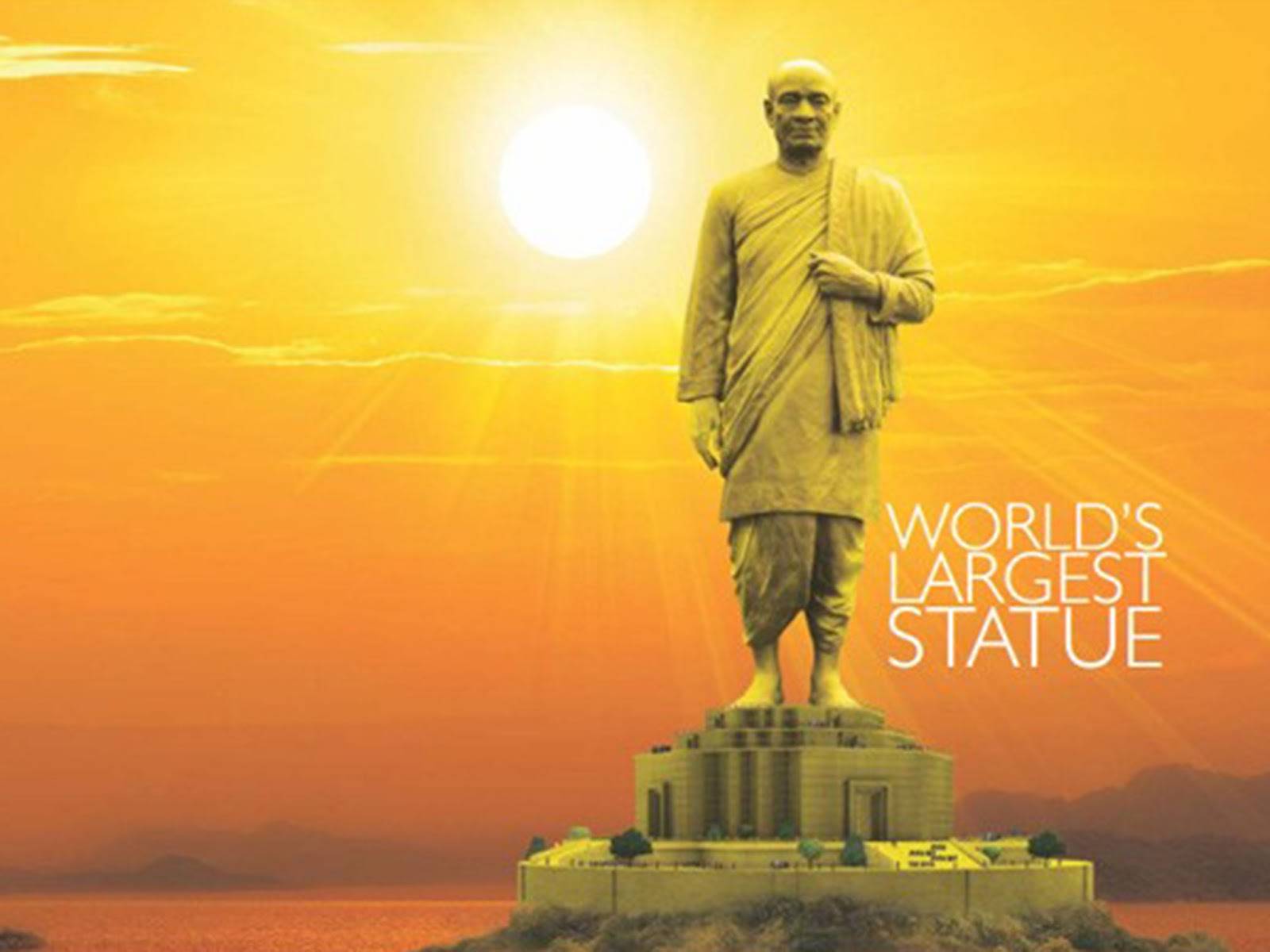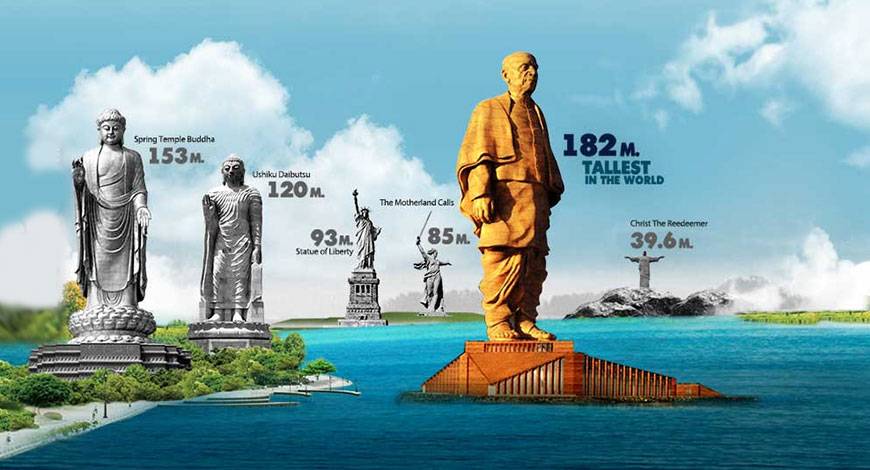Entrepreneur | Posted on |
The Statue Of Unity - World's Tallest Statue
0
2035 Views
Congratulations! India is now home to the world's tallest statue.
A 182-metre (600-foot) bronze-clad tribute to Sardar Vallabhbahi Patel, the country's first deputy prime minister credited with persuading more than 550 princely states to join the Indian union after independence in 1947.
On the day Sardar Patel was born, air-force jets showered flower petals on the Statue of Unity looking over the Narmada river in Gujarat, his home state and that of PM Narendra Modi, who inaugurated the giant effigy.

"They considered our diversity our biggest weakness but Sardar Patel converted this into our biggest strength. India is moving ahead on the path shown by him," Modi said as he revealed the statue designed by Ram V. Sutar, a prolific 93-year-old sculptor, on Oct 31.
A lot went into its making of the 67,000-tonnes structure, which engineers say can withstand powerful earthquakes and high-speed winds.
Surrounded by an 12-sq-km artificial lake, the world's tallest statue of Unity covers 20,000 sq meters and is twice the size of New York's Statue of Liberty.
Built by several hundred workers from China, the towering likeness of Sardar Patel dwarfs China's 128-metre Spring Temple Buddha.
Remember, the project was commissioned way back in 2010, when Modi was chief minister of Gujarat.
Political analysts described the move as the BJP's attempt to embrace the legacy of Sardar Patel from the opposition Congress party in a bid to appropriate a role in India's freedom struggle.
But eight years down the line since the Patel statue was envisioned, a lot has changed in India.
Flash back to 2011-12: public disaffection with the Congress-led UPA government came out on the streets with the anti-corruption movement led by veteran activist Anna Hazare.
Let's Also Recall What Spurred The Agitation. Those Were Notional Figures That The Comptroller And Auditor General Had Leaked To Suggest The Exchequer Lost An Estimated Rs 1.76 Lakh Crore When The Manmohan Singh Government Awarded Airwave Licenses In 2008 At 2001 Rates.
The same case, which had pushed Modi to national power in 2014, was rejected by the trial court last year. It acquitted former telecommunications minister Andimuthu Raja on charges of corruption and cheating in connection with the spectrum sale.

"A huge scam was seen by everyone where there was none," the court ruled. "Some people created a scam by artfully arranging a few selected facts and exaggerating things beyond recognition to astronomical levels,” read the verdict.
The stunning ruling took the air out of Modi's anti-corruption crusade barely a year after his abrupt demonetisation had caused a massive disruption in the economy.
Remember the note ban of November 2016? The measure, which was heavily extolled through a nationalist propaganda, has been dismissed by world-class economists as a gimmick at the cost of national economy.
"By a 99.3% verdict, India’s cash ban was a farce," said the headline of a Bloomberg column by financial expert Andy Mukherjee.
"The exercise was supposed to freeze out black money, but virtually all flooded back," it added.
After the RBI's annual report concluded this year that 99.3 percent of the banknotes Modi cancelled ostensibly to wipe out "black money" from the $2.5-trillion economy were returned, Mukherjee described the exercise as a "gigantic anti-climax".
"... when you freeze agriculture and small businesses with a liquidity shock, put people through unnecessary hardship, disrupt supply chains, and destroy demand for everything from autos to property, the end result can’t be such a gigantic anticlimax: 107 billion rupees ($1.5 billion) weeded out from a $2.5 trillion economy," he wrote.
In his inaugural year, the prime minister launched a flagship "Make-in-India" campaign. On paper, the 2014 reform aimed at boosting manufacturing to 25 percent of India’s economy by 2020 and create millions of jobs.
But the World Bank isn't impressed with the results. It's latest data show manufacturing has in fact now shrunk to about 15 percent of the GDP from a peak of 18.6 percent in 1995.
Other data show new investments in India have dropped and stalled projects are on the rise, Bloomberg said in its July report.
The Modi government's Skill India program designed to prepare 40 crore Indians for the job market by 2022 has also faltered.
Data suggest 64 percent of citizens are expected to be in the working age group of 15-59 years by 2026.
But a report by the Centre for Sustainable Employment of the Azim Premji University paints a dreary picture.

"Unemployment levels have been steadily rising, and after several years of staying around 2-3%, the headline rate of unemployment reached 5% in 2015, with youth unemployment being a very high 16%," the State of Working India 2018 findings said. "This rate of unemployment is the highest seen in India in at least the last 20 years," it warned.
The report noted that job shortages were compounded by depressed wages, with 82% of men and 92% of women earning less than Rs 10,000 per month.
There are numerous other economic indicators from a variety of sectors, including the mammoth agriculture, which suggest that the Modi government's response to India’s pressing problems has been far from satisfactory.
All that probably explains the statue politics -- Rs 3,000 crore spent on appropriating a historic icon in what appears to be one more in a series of experiments to stir nationalist emotions once again before the 2019 general elections.
Aside of the Indian media's pro-Modi rants, some tough, legitimate questions do arise.
Is India moving back in time? What are our priorities -- pandering to religious sentiments or preparing the nation for momentous economic challenges, present and future?
For how long will Indians be deceived with events and projects that are symbolic?Doesn't India deserve materially useful deliverables? I wonder.
